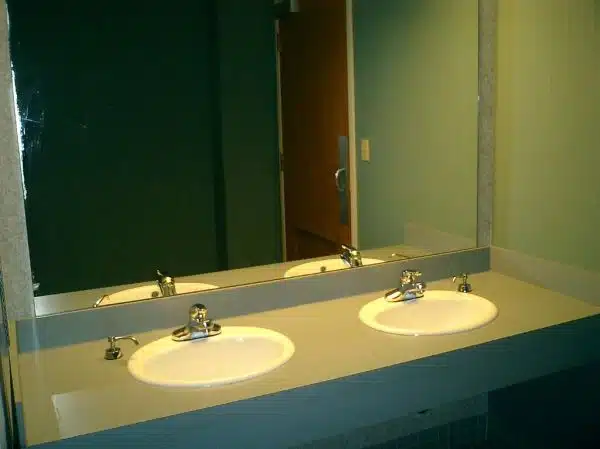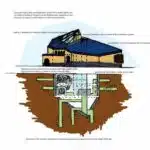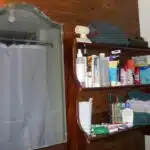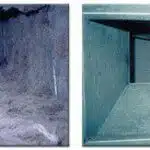Mold is a common problem in many households, and bathrooms are one of the most susceptible areas for mold growth. Not only does it look unsightly and emit an unpleasant odor, but mold can also pose health risks to individuals with allergies or respiratory issues. As a mold prevention expert, I have seen firsthand the negative effects that mold can have on homes and their inhabitants. However, there are several simple steps that homeowners can take to prevent mold growth in their bathrooms.
Firstly, it’s important to understand what causes mold in the bathroom. Bathrooms are typically moist environments due to the presence of water from showers, baths, and sinks. This moisture creates an ideal breeding ground for mold spores to grow and spread. Additionally, poor ventilation can exacerbate this issue by trapping moisture in the air and preventing it from properly drying out. By understanding these factors, homeowners can take proactive measures to prevent mold growth and maintain a healthy living environment for themselves and their families.
Understanding The Causes Of Bathroom Mold
As a mold prevention expert, it is important to understand the causes of bathroom mold in order to effectively prevent its growth. Bathroom mold grows in areas with high moisture levels and poor ventilation. This could be due to a lack of or inadequate ventilation systems, constant hot showers or baths, or leaks from pipes and faucets. Additionally, bathrooms that are not regularly cleaned allow for moisture and dirt buildup which provides a breeding ground for mold spores.
Preventing bathroom mold requires a combination of techniques aimed at reducing moisture levels and ensuring proper ventilation. One technique is to ensure that your bathroom has proper ventilation, either through an exhaust fan or by opening windows after showering. You can also consider using a dehumidifier to reduce humidity levels in your bathroom. Regular cleaning of your bathroom will also help prevent mold growth by removing any dirt that may trap moisture.
Another prevention technique is fixing any plumbing issues promptly. Leaky pipes and faucets create damp environments which promote the growth of mold spores. Lastly, keeping surfaces dry after use can also help reduce moisture levels in your bathroom. By taking these preventative measures, you can reduce the likelihood of bathroom mold growth and maintain a clean and healthy environment for yourself and others.
Moving forward, it is important to identify early signs of mold growth in order to take immediate action before it spreads further.
Identifying Early Signs Of Mold Growth
As a mold prevention expert, it’s important to recognize the early signs of mold growth in your bathroom. Many people are unaware that mold can grow in their homes until it’s too late. Common misconceptions include believing that mold only grows on visible surfaces or that it’s harmless. However, this couldn’t be further from the truth. Mold can grow on any surface, visible or not, and it can lead to serious health risks if left untreated.
One of the most effective cleaning methods for preventing mold growth is to keep your bathroom clean and dry at all times. This means wiping down any wet surfaces immediately after use and using a dehumidifier to keep the air moisture-free. DIY solutions such as vinegar or baking soda can also be used to clean and disinfect surfaces. However, these should not be relied upon solely for preventing mold growth.
It’s important to note that even with proper cleaning and maintenance, bathrooms are still susceptible to mold growth without proper ventilation. Maintaining proper ventilation is key to preventing the buildup of moisture in your bathroom. This includes using exhaust fans during and after showers and opening windows when possible. By recognizing early signs of mold growth, utilizing effective cleaning methods, and maintaining proper ventilation, you can prevent the harmful effects of mold in your bathroom.
Maintaining Proper Ventilation
- Installing exhaust fans is an effective way of reducing the buildup of moisture and preventing mold growth in the bathroom.
- Air circulation should be maintained to ensure that the moisture created by showers and baths is removed, and exhaust fans should be used to help circulate the air.
- It is important to regularly check and clean the grills of exhaust fans to ensure that they are working properly and do not become blocked.
- Proper ventilation is also essential for reducing humidity levels and should be monitored to prevent the growth of mold in the bathroom.
Installing Exhaust Fans
Proper ventilation is crucial in preventing mold growth in your bathroom. One of the most effective ways to achieve this is by installing exhaust fans. The benefits of ventilation go beyond just mold prevention; it also helps improve air quality by removing excess moisture and unpleasant odors.
When choosing the right exhaust fan for your bathroom, consider the size of the room and the level of activity that takes place in it. A more powerful fan may be necessary for a larger bathroom or one that sees frequent use. It’s also important to choose a fan with a noise level that’s tolerable for you and your family.
Installing an exhaust fan can be a simple yet effective solution to prevent mold growth in your bathroom. By improving air circulation and reducing moisture levels, you can create a healthier environment for yourself and your loved ones. Don’t wait until mold becomes a problem; take action now to ensure proper ventilation in your home.
Maintaining Air Flow
Proper ventilation is key to preventing mold growth in your bathroom. Aside from installing an exhaust fan, maintaining air flow is also crucial to keep your bathroom free from mold. Air flow helps in reducing moisture levels and improving air quality, which are both essential for a healthy indoor environment.
One practical way of maintaining air flow in your bathroom is by keeping the door open after a shower or bath. This allows the moist air to escape and circulate throughout the rest of the house. Another way is by opening windows, especially during warmer months when humidity levels are high.
Choosing the right exhaust fan is still the most effective method of maintaining proper ventilation in your bathroom. It’s important to consider the size of your bathroom and usage level when selecting an exhaust fan. A more powerful fan may be necessary for larger bathrooms or ones that see frequent use. Remember that proper ventilation has numerous benefits beyond just mold prevention; it also improves air quality and reduces unpleasant odors, creating a healthier environment for you and your loved ones.
Installing Exhaust Fans
Installing exhaust fans is one of the most effective ways to prevent mold growth in your bathroom. When you take a shower or bath, moisture builds up in the air and creates an ideal environment for mold spores to thrive. By installing an exhaust fan, you can remove excess moisture from the air and prevent it from accumulating on surfaces like walls and ceilings. This can greatly reduce the risk of mold growth in your bathroom.
One of the benefits of ventilation is that it helps to improve indoor air quality. Poor indoor air quality can lead to a range of health problems, including respiratory issues, headaches, and fatigue. By removing excess moisture from the air with an exhaust fan, you can help to prevent these issues and create a healthier living environment for your family.
When choosing the right exhaust fan for your bathroom, there are several factors to consider. First, you’ll need to determine the size of your bathroom so that you can choose a fan with adequate power to effectively circulate air. You’ll also want to consider noise level, energy efficiency, and ease of installation. A good exhaust fan should be quiet enough that it won’t disturb your daily routine but powerful enough to remove moisture quickly and efficiently.
Incorporating an exhaust fan into your bathroom is a simple yet effective way to prevent mold growth. By removing excess moisture from the air and improving indoor air quality, you can create a healthier living environment for yourself and your family while also reducing the risk of costly mold damage. In our next section, we will discuss another important step in preventing mold growth: using dehumidifiers.
Using Dehumidifiers
Dehumidifiers are a useful tool in preventing mold growth in bathrooms. These devices work by removing excess moisture from the air, which is one of the main factors that contribute to mold growth. By reducing humidity levels, dehumidifiers can create an environment that is less conducive to mold growth.
One of the benefits of using a dehumidifier is that it can be a cost-effective way to prevent mold. While there may be some upfront cost associated with purchasing a dehumidifier, it can save you money in the long run by preventing costly mold remediation services. Additionally, running a dehumidifier does not require any special skills or knowledge, making it an easy and accessible option for anyone looking to prevent mold growth.
Overall, using a dehumidifier in your bathroom can have many benefits when it comes to preventing mold. Not only is it cost effective, but it also requires minimal effort on your part. By investing in a dehumidifier and regularly monitoring humidity levels in your bathroom, you can significantly reduce the risk of mold growth and ensure that your bathroom remains a healthy and safe space.
To further reduce the risk of mold growth in your bathroom, another important step is to wipe down surfaces after use. By removing any excess moisture left behind from showering or bathing, you can limit the amount of water available for mold to grow. This simple step can be done quickly and easily with a towel or squeegee and should be incorporated into your regular cleaning routine.
Wiping Down Surfaces After Use
Did you know that wiping down surfaces in your bathroom can be a game-changer in preventing mold growth? According to a recent study, damp surfaces are more likely to grow mold, which can pose a serious health risk to individuals with respiratory issues. Wiping down your bathroom surfaces after use can reduce the moisture levels and prevent mold from growing.
Benefits of wiping down surfaces after use include reducing the amount of moisture in the bathroom, preventing mold growth, and improving overall air quality. By keeping the bathroom clean and dry, you can avoid potential health risks associated with mold exposure. Additionally, regular cleaning of surfaces can prevent the buildup of soap scum and other contaminants that contribute to poor air quality.
Alternative methods for wiping down surfaces after use include using a squeegee or towel to remove excess water from shower walls and floors. You may also consider using a dehumidifier to reduce moisture levels in the bathroom. These alternative methods, combined with regular cleaning, can significantly reduce the likelihood of mold growth in your bathroom.
To further prevent mold growth in your bathroom, it is essential to address any leaks or damaged pipes promptly. Leaks provide an optimal environment for mold growth and increase the chances of structural damage to your home. In the next section, we will discuss how fixing leaks and damaged pipes can help prevent mold growth in your bathroom.
Fixing Leaks And Damaged Pipes
Identifying leaks is an important first step in preventing mold growth in bathrooms. Regular inspections of pipes and fixtures should be conducted to locate any potential sources of water leakage. To repair damaged pipes, a plumber should be consulted and the necessary repairs should be made as soon as possible. Sealing cracks in pipes is essential for preventing water from entering and causing further damage. Replacing corroded pipes can help to reduce the likelihood of future water damage. Proper maintenance and repair of pipes and fixtures can help to prevent water from accumulating and leading to mold growth. Sealing the area around pipes and fixtures can also help to prevent water from entering the walls and causing damage.
Identifying Leaks
As a mold prevention expert, one of the most crucial steps to prevent mold in your bathroom is identifying leaks. Common leak sources include damaged pipes, loose fittings, and faulty valves. Even the smallest leaks can cause significant water damage and create an ideal environment for mold growth. Therefore, it’s essential to be vigilant in detecting any signs of leaks and address them immediately.
DIY leak detection is a simple process that can save you from costly repairs down the line. Start by turning off all water-using appliances in your home and take a meter reading. Afterward, wait for an hour or two before taking another reading. If there’s a change in the meter reading, then you have a leak somewhere in your plumbing system. Check all visible pipes for signs of water damage or rust and ensure that all fittings are tight.
Additionally, check for any dampness or discoloration on walls or floors adjacent to your bathroom as these may indicate hidden leaks. Musty odors are also common indicators of leaking pipes behind walls or under floors. If you notice any unusual smells, call in a professional plumber to conduct a thorough inspection of your plumbing system. In conclusion, detecting and fixing leaks promptly is critical to preventing mold growth and ensuring that your bathroom remains clean, healthy, and safe for use.
Repairing Pipes
Now that we’ve discussed the importance of identifying leaks, let’s move on to the next crucial step in preventing mold growth in your bathroom: repairing pipes. Common pipe issues include cracks, corrosion, and clogs, which can lead to water damage and create an ideal breeding ground for mold. As a mold prevention expert, I highly recommend addressing any pipe issues as soon as possible to avoid costly repairs down the line.
If you’re handy, DIY pipe repair is possible for minor issues such as small cracks or leaks. However, it’s essential to have basic plumbing knowledge and the right tools before attempting any repairs. You’ll need to turn off the water supply and drain any remaining water from the affected pipes before proceeding with repairs. For small cracks or leaks, use epoxy putty or plumber’s tape to seal them temporarily. Remember that these are only temporary fixes and that you’ll eventually need to replace the damaged sections of pipe.
For more complex or extensive pipe damage, it’s best to call a professional plumber immediately. Attempting major repairs without proper training can lead to further damage or even injury. A trained plumber can diagnose the problem correctly and offer solutions that fit your specific needs and budget. Regular maintenance of your plumbing system can prevent most issues from occurring in the first place, so make sure to keep up with scheduled inspections and tune-ups.
Sealing Cracks
Now that we’ve discussed the importance of repairing pipes to prevent mold growth in your bathroom, let’s focus on one of the most common pipe issues: cracks. Cracks can lead to leaks and water damage, creating an ideal environment for mold growth. As a mold prevention expert, I highly recommend addressing any cracks as soon as possible to avoid costly repairs down the line.
The benefits of sealing cracks are numerous. By sealing them, you can prevent water from leaking out and causing damage while also preventing moisture from seeping into your walls and floors. Sealing cracks also helps to maintain stable humidity levels in your bathroom, which is essential for preventing mold growth. The best materials for sealing cracks depend on the location and size of the crack. For small cracks, epoxy putty or plumber’s tape can provide a temporary fix until you can replace the section of damaged pipe. For larger cracks or more extensive damage, it’s best to call a professional plumber immediately.
Regular maintenance of your plumbing system can prevent most issues from occurring in the first place, so make sure to keep up with scheduled inspections and tune-ups. Sealing cracks is just one part of maintaining a healthy plumbing system that prevents mold growth in your bathroom. By staying proactive about identifying and repairing any issues with your pipes, you can save yourself time, money, and stress in the long run. Remember that even small leaks or cracks can lead to significant problems if left unaddressed- don’t hesitate to call a professional if you’re unsure how to proceed with repairs.
Sealing Grout And Caulking
Grout cleaning and caulking techniques are crucial in preventing mold growth in the bathroom. Grout is porous, and it can absorb moisture easily, which makes it a perfect breeding ground for mold. Therefore, it’s essential to clean the grout regularly using an appropriate cleaner to prevent mold from forming. One of the most effective grout cleaners is a mixture of baking soda and water. This solution helps to remove dirt and stains without damaging the grout.
Caulking is another area that needs attention when preventing mold growth in the bathroom. Caulk is used to seal gaps between tiles or around fixtures such as sinks and bathtubs. It prevents water from seeping through cracks and causing damage. However, caulk can also be a breeding ground for mold if not maintained correctly. To prevent this, it’s important to use high-quality caulk that’s resistant to mildew and mold. Additionally, make sure to replace any old or damaged caulk promptly.
Proper grout cleaning and caulking techniques will go a long way in preventing mold growth in your bathroom. By keeping these areas clean and well-maintained, you’ll reduce the chances of moisture buildup that leads to mold formation. Remember to clean your grout regularly using baking soda and water solution while replacing old or damaged caulk promptly with high-quality products that have mildew-resistant properties. In the next section, we’ll discuss how using mold-resistant paints and materials can further help prevent bathroom mold growth.
Using Mold-Resistant Paints And Materials
Mold can be a pesky problem in any bathroom, but with the right tools and techniques, it can be prevented. Using mold-resistant materials and painting techniques is an excellent way to keep mold from growing in your bathroom. Just like how a knight uses a shield to protect themselves from harm, using these materials acts as a barrier against mold growth.
One of the most important steps in preventing mold growth is selecting the right materials for your bathroom. Mold-resistant materials like drywall, paint, and caulk are specifically designed to resist moisture and prevent mold growth. When selecting materials for your bathroom renovation or remodeling project, be sure to look for products that are labeled as “mold-resistant” or “moisture-resistant.” These products will not only help prevent mold growth but also last longer than traditional materials.
In addition to using mold-resistant materials, painting your bathroom with anti-microbial paint is another effective method of preventing mold growth. This type of paint contains special additives that help prevent the growth of bacteria and fungi. Applying this type of paint on walls and ceilings can significantly reduce the likelihood of mold spores from forming. Remember that prevention is always better than cure when it comes to keeping your bathroom free from harmful molds.
To maintain a clean and healthy bathroom environment, regularly cleaning and disinfecting all surfaces is essential. In the next section, we will discuss some effective methods for keeping your bathroom clean and free from germs.
Regularly Cleaning And Disinfecting
Using mold-resistant paints and materials is a great first step in preventing bathroom mold, but it’s not enough on its own. Regular cleaning and disinfecting of your bathroom is vital to keeping mold at bay. In fact, cleaning your bathroom regularly is one of the most effective ways to prevent mold growth.
One effective way to clean your bathroom is by using steam cleaning. Steam cleaning has many benefits when it comes to preventing mold growth. Not only does it kill bacteria and germs, but it also eliminates moisture in hard-to-reach areas. High humidity levels are a major contributor to mold growth, so reducing moisture in your bathroom is crucial to preventing mold from forming.
When choosing disinfectants for your bathroom, you want to use products that are specifically designed for killing mold and mildew. The best disinfectants for bathroom mold are those that contain bleach or hydrogen peroxide. These ingredients have been proven effective at killing mold spores and preventing them from returning. It’s important to follow the manufacturer’s instructions when using these products, as they can be harmful if not used properly.
Transition: While regular cleaning and disinfecting with steam cleaners and strong chemicals can be effective at keeping mold at bay, some people prefer more natural remedies for preventing mold growth in their bathrooms. In the next section, we will explore some natural alternatives that can help keep your bathroom clean and healthy without relying on harsh chemicals or equipment.
Using Natural Remedies For Mold Prevention
Good ventilation is essential in preventing mold growth in the bathroom, as it helps to reduce moisture levels and airflow. The use of essential oils such as tea tree, lavender and eucalyptus oil can help to inhibit the growth of mold, as they have antifungal and antibacterial properties. It is also important to regularly clean and dry the bathroom, as this helps to make it an inhospitable environment for mold. Finally, keeping the bathroom well ventilated and using natural remedies such as essential oils can help to prevent the growth of mold.
Ventilation
Are you tired of constantly dealing with mold in your bathroom? It can be frustrating to clean it up over and over again, not to mention the potential health hazards it poses. Fortunately, there is a simple solution that can prevent mold growth altogether: ventilation. By ensuring proper air circulation in your bathroom, you can enjoy a mold-free environment and all the benefits that come with it.
The benefits of ventilation are numerous. Firstly, it helps to reduce humidity levels which are a prime breeding ground for mold. Secondly, it improves air quality by removing unpleasant odors and preventing the buildup of harmful substances such as carbon monoxide and radon. Additionally, proper ventilation can also prevent damage to your walls, ceilings, and floors by reducing excess moisture that can cause warping or cracking.
There are several types of ventilation systems available on the market today. The most common ones include exhaust fans, ceiling-mounted fans, and wall-mounted fans. Each system has its own unique advantages depending on the size and layout of your bathroom. For instance, exhaust fans work best in small bathrooms while ceiling-mounted fans are better suited for larger spaces. Regardless of which system you choose, make sure to have it installed by a professional to ensure optimal performance and safety. Remember: prevention is key when it comes to mold control!
Essential Oils
As a mold prevention expert, I understand the appeal of using natural remedies to combat this pesky problem. One such remedy that has gained popularity in recent years is the use of essential oils. While essential oils may offer some benefits for preventing bathroom mold, it’s important to also consider their drawbacks.
One benefit of using essential oils is their natural antifungal and antibacterial properties. Some oils, such as tea tree oil and eucalyptus oil, have been shown to effectively inhibit mold growth when used in combination with other cleaning methods. Additionally, essential oils can help improve air quality by providing a pleasant scent that masks unpleasant odors.
However, it’s important to note that not all essential oils are effective for mold prevention and some may even pose health risks if used improperly. For instance, cinnamon bark oil can be irritating to the skin and lungs if not diluted properly. Furthermore, while essential oils may provide temporary relief from mold growth, they should not be relied upon as the sole method of prevention.
In conclusion, while there are benefits to using essential oils for mold prevention in your bathroom, it’s important to do so with caution and in conjunction with other preventative measures such as proper ventilation and regular cleaning. The best essential oils for preventing bathroom mold include tea tree oil, eucalyptus oil, and lavender oil. As always, consult with a professional before using any new products or remedies in your home.
Hiring Professional Mold Inspection Services
Imagine you’ve cleaned your bathroom thoroughly and thought that it was mold-free. However, after a few days, you notice black spots forming on the walls and ceilings. You try to clean them again, but they keep coming back. This is where professional mold inspection services come in handy.
Benefits of Professional Mold Inspection Services:
- Professionals are trained to detect the signs of mold growth that may not be visible to an untrained eye.
- They can help identify the root cause of mold growth and provide guidance on how to prevent it from occurring in the future.
- Their expertise allows for safe and effective removal of mold without causing further damage to your property.
Although hiring professional mold inspection services may seem costly at first, it is actually cost-effective in the long run. By detecting mold growth early on, you can prevent further damage to your property, which could save you thousands of dollars in repair costs.
In addition, professional mold inspectors use specialized equipment and techniques that can detect hidden moisture sources that may be causing mold growth. By identifying these sources, they can help prevent future outbreaks and ensure a safe living environment for you and your family.
Transition: Now that we’ve discussed the benefits and cost-effectiveness of professional mold inspections, let’s move on to how to safely and effectively remove existing mold from your bathroom.
Removing Mold Safely And Effectively
Safe removal and effective treatment of mold in your bathroom is essential to prevent health hazards caused by exposure to mold spores. Mold can be removed safely and effectively using a combination of methods such as mechanical, chemical, or natural approaches. Mechanical removal involves physically scrubbing the affected area with a brush and water, while chemical removal involves using commercial cleaners that contain bleach or hydrogen peroxide. Natural removal includes the use of vinegar or baking soda solutions.
To ensure safe removal of mold, it is important to wear protective gear such as gloves, goggles, and respirators. When using commercial cleaners, follow the manufacturer’s instructions carefully and avoid mixing different types of chemicals as this can produce harmful fumes. It is also essential to provide adequate ventilation during the cleaning process by opening windows or using fans to circulate air.
Effective treatment of mold requires identifying and addressing the underlying cause of moisture in your bathroom. Common sources of moisture include poor ventilation, leaky pipes, or high humidity levels. Once the source has been identified and fixed, it is important to thoroughly dry the affected area as soon as possible to prevent future mold growth.
| Type of Removal | Advantages | Disadvantages |
|---|---|---|
| Mechanical | No chemicals involved; effective for small areas | Labor-intensive; may not remove all mold |
| Chemical | Effective for large areas; kills bacteria and viruses | Harsh chemicals may cause respiratory irritation |
| Natural | Non-toxic alternative; affordable | May not be effective for heavy infestations |
Taking precautions to prevent future mold growth involves regular cleaning and maintenance of your bathroom. Ensure proper ventilation by installing exhaust fans or opening windows during showers or baths. Fix any leaks immediately and monitor humidity levels with a hygrometer to ensure they stay below 60%. Regularly clean surfaces with vinegar or other natural alternatives to prevent the buildup of moisture and mold spores. By following these tips, you can maintain a healthy and mold-free bathroom environment.
Taking Precautions To Prevent Future Mold Growth
After safely and effectively removing mold from your bathroom, it’s important to take precautions to prevent future growth. Regular maintenance is key in preventing mold from returning. This includes wiping down surfaces after each use, fixing any leaks or water damage promptly, and ensuring proper ventilation in the bathroom.
In addition to regular maintenance, professional cleaning can also help prevent mold growth. A professional cleaner can thoroughly clean areas that may be difficult to reach or clean properly on your own, such as grout lines or showerheads. They can also identify potential problem areas and provide recommendations for preventing future mold growth.
It’s important to educate yourself and your family on mold prevention practices. This includes understanding the signs of mold growth, such as a musty smell or visible discoloration on surfaces, and knowing how to properly clean and maintain your bathroom. By taking these preventative measures, you can ensure a healthy and safe environment for you and your family.
Educating Yourself And Your Family On Mold Prevention Practices
Families play a crucial role in preventing mold growth in their homes. It is important to educate yourself and your family on the best practices for mold prevention. This can include learning about the causes of mold growth, the signs of a mold problem, and how to effectively clean and prevent future mold growth.
Family education should begin with understanding the causes of mold growth. Mold thrives in damp and humid environments, making bathrooms particularly vulnerable. Educating your family on proper ventilation techniques, such as opening windows or running exhaust fans during showers, can help reduce moisture in the bathroom and prevent mold growth. Additionally, it is important to regularly check for leaks or water damage that could contribute to mold growth.
In addition to education, there are also many DIY solutions for preventing mold in your bathroom. Regular cleaning with vinegar or hydrogen peroxide can help kill any existing mold spores and prevent future growth. Installing a dehumidifier can also help reduce moisture levels in the bathroom. By incorporating these preventative measures into your routine, you can effectively protect your family from harmful mold exposure.
Conclusion
Bathroom mold is a common problem that can lead to serious health issues if left unchecked. Understanding the causes of mold growth and identifying early signs can help prevent its spread. Proper ventilation, installation of exhaust fans, and use of dehumidifiers are all effective ways to control moisture levels in your bathroom. Hiring professional mold inspection services when necessary and removing mold safely and effectively are crucial steps in preventing future mold growth.
Taking precautions such as regularly cleaning your bathroom and ensuring proper drainage can also go a long way in preventing the spread of mold. Educating yourself and your family on mold prevention practices is essential for maintaining a healthy living environment. By following these simple steps, you can protect your home from the harmful effects of bathroom mold. As a mold prevention expert, I strongly advise homeowners to take proactive measures to prevent mold growth before it becomes a major issue.
Image Credits
- “bathroom” by dhlynsky (featured)





























